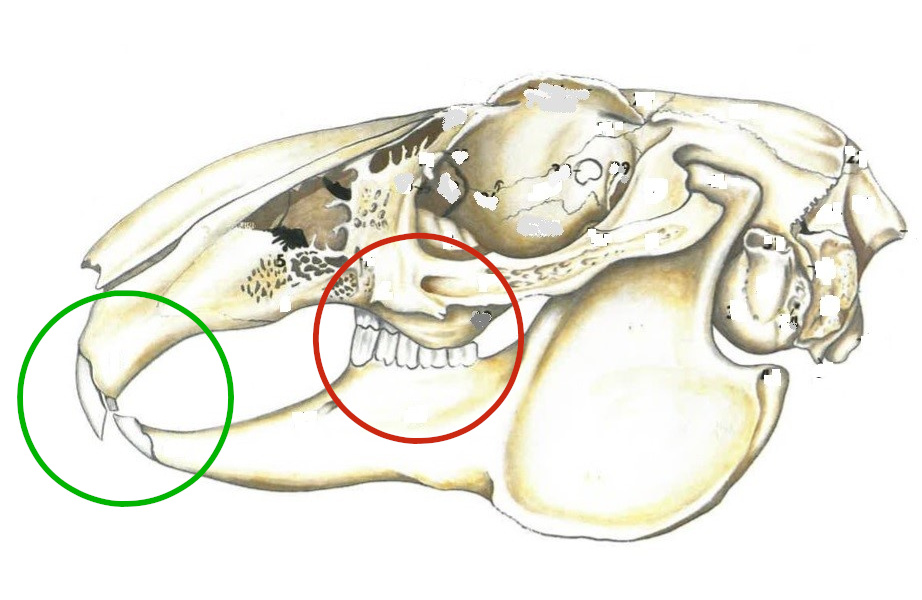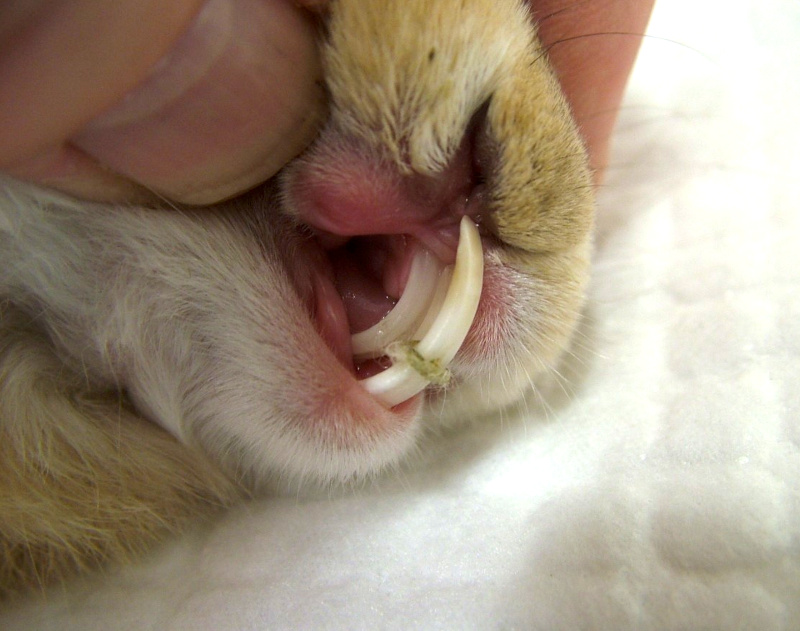Dental anatomy and function
Rabbits have continuously growing incisor and cheek teeth without true anatomical roots.
Incisors (front teeth)
- Rabbits have two lower and four upper incisors (The second, smaller, pair of upper incisor teeth are located behind the first incisors, and are often termed peg teeth)
- The upper incisors are shorter than the lower incisors.
- When the mouth is closed, the tips of the lower incisors rest just behind the larger upper incisors, in front of the peg teeth.
Molars and premolars (cheek teeth)
- There are six upper cheek teeth and five lower cheek teeth.
- Although termed premolars and molars, the cheek teeth are all identical.

The upper dental arcade (the row of teeth in the upper jaws) is wider than the lower. When rabbits chew, their jaws go backwards and forwards, and side to side. This results in a ‘circular’ chewing motion that wears the teeth down, preventing them from overgrowing.
Good dental health
Good dental health is reliant on:
Normal anatomy
This can be affected by:
- Congenital problems – for example, many dwarf breeds have shortened faces with overcrowded mouths. This results in malocclusion of the teeth (i.e., they don’t meet their opposing teeth normally, and often grow at odd angles), and they can’t wear down normally)
- Acquired problems – poor diet, inadequate exposure to sunlight (leading to a Vitamin D3 deficiency and, consequently soft bones), or trauma can cause malocclusions of the teeth.
Normal chewing action
Rabbits normally chew long fibrous hay and grass, using the circular motion described above. Chewing ‘muesli’ type diets (lucerne pellets and chaff, grain, and molasses) causes them to chew up and down and this means that the teeth don’t wear down normally.
Appropriate bone density
Good bone density is achieved by 1) exposure to sunlight (and therefore light in the UVB wavelengths), 2) production of Vitamin D3 through the action of UVB light, 3) adequate calcium in the diet, and 4) exercise of the jawbones through chewing hard fibrous foods.
If any, or all, of these factors are absent of abnormal, the cheek teeth and incisors may overgrow and cause dental disease.

What does dental disease look like?
- Drooling (slobbers) with saliva matting the chin and under the neck
- Loss, or reduced, appetite
- Weight loss – seen as a prominent spine and pelvic bones
- Diarrhoea
- Swelling on the upper or lower jaws, often painful to touch
- White discharge from the eye and sometimes the nose. This is due to blockage of the tear duct, and is often mistaken for conjunctivitis.
How will your vet diagnose dental disease in your pet rabbit?
After taking a history from you and doing a physical examination of your rabbit, your vet will need to examine your bunny’s teeth and take some X-rays to assess all the teeth and the jaw bones more closely. This requires taking a lot of X-rays or even a CT. In order to do this, your bunny will probably need to be anaesthetised.
How are dental problems treated?
This will depend on the extent and the severity of the problem. Your vet, after discussing it with you, may need to trim and re-shape some teeth, or even extract them. Teeth root abscesses will require surgery and antibiotics.
Because their teeth are constantly growing, this treatment will probably need to be repeated every 3-4 weeks until controlled. Some rabbits require lifelong treatment.
Before embarking on this treatment course, your vet will want to discuss the treatment plan, the costs, and the likely outcome for your bunny. Sadly, in some cases, euthanasia may be in your bunny’s best interests.
Prevention
Preventing dental disease revolves around:
- Discouraging the breeding of rabbits with shortened faces. Don’t buy them because ‘they look cute’. Breeders will continue to supply the demand from the public for these breeds – only by lowering the demand can we hope to lower the number of bunnies destined for poor health.
- Feed your bunny a healthy diet. See our article on feeding rabbits here.
- Make sure your rabbit gets some direct, unfiltered sunlight for at least five hours a week.
References
1. Harcourt-Brown F (2002) Textbook of rabbit medicine. Butterworth Heinemann
2. Varga M, Harcourt-Brown F (2014) Textbook of Rabbit Medicine, 2nd ed. Elsevier

